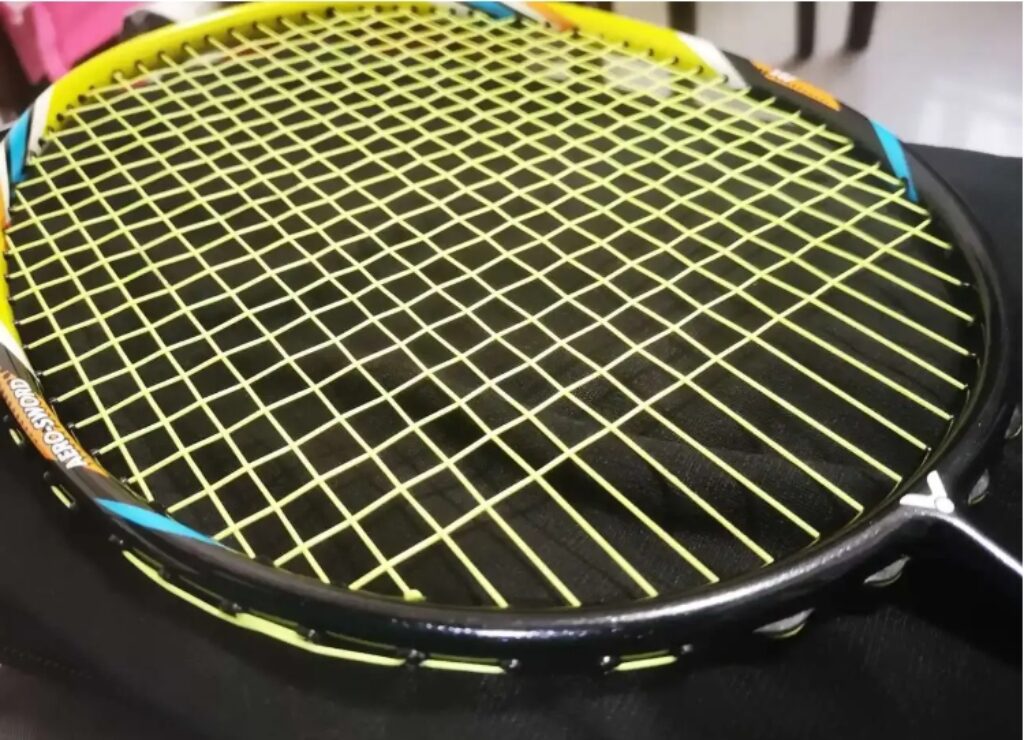One of the Choices for Entry-Level Rackets with a Hard Feel
Creating a hard-feeling racket in the entry-level category is not very popular, as the target group mainly consists of beginners who might struggle with such a racket.
In this price range, the JetSpeed 03H is quite distinctive. To my knowledge, another racket in this tier with a similar hard feel is the Power Black Mamba 5. However, the 03H is not only cheaper than the latter but also comes with a warranty of up to 34 lbs…
It seems quite hardcore. So, is it easy to use?

Parameters: 3UG5, stripped of bottom, used condition 92.0g, balance point 299mm, 6.8mm shaft, 215mm length, hard feel, oval wind-breaking transition diamond frame, 9-3 o’clock string grooves, 76-hole string bed, warranty 34 lbs, strings 28-30 lbs VBS70.
The bright yellow is vibrant, and in terms of color choices, the 03H is my preferred type. Victory’s yellow rackets often excite my interest, much like the sour bamboo shoots. The details are not lacking, which can rival the JetSpeed 2SP. Besides the yellow and black color scheme, some lines and fonts in bright blue create a color contrast that enhances the racket’s visual depth. Although the warranty pounds are very high, the frame thickness has not increased significantly compared to the JetSpeed series, with more emphasis on the oval frame. It looks good, feels speedy, and that’s what matters.

Additionally, based on my experience, FRS generally causes the racket face to feel slightly wooden, which is a trade-off.
The racket feels balanced upon handling. Compared to the previous TK100F, both rackets are relatively heavy, but the JetSpeed 03H should have slightly lower swing weight, although this is not evident from the balance point value. Perhaps due to the string configuration, the shock absorption of this racket is not as good as expected. The TK100F also has some residual shock, but not as pronounced as this racket. However, given that this racket is strung at high tension, I have no complaints; “one must endure the bitterness of salted fish to enjoy the sweetness.”

Excluding the high string tension factor, the difficulty level of handling this racket is at the threshold between beginner and intermediate. Beginners might find the shaft a bit stiff. However, in swing strikes, it offers both a sense of leverage and good power, with a smooth swing process. I believe that with proper swing techniques, using the JS03H to hit the baseline should not be an issue, although the 3U version is relatively more energy-consuming.
The JS03H performs well in swing speed. Although it is not extremely sharp, it is among the top in its price range and specifications, being slightly faster and more flexible. Some might argue that choosing an ultra-light racket could also provide good swing speed, but ultra-light rackets usually sacrifice solid feel, which the 03H does not. For beginners who prioritize weight and speed, I strongly suggest comparing the feel of 3U rackets with lower balance points and 5U rackets with higher balance points in flat drives before making a decision.

Moreover, the racket frame has high rigidity, and the shot style is crisp. Even when paired with VBS70 strings known for durability, the shots do not feel sluggish at high tensions. In summary, the JS03H is not a racket that fears fast-paced mid-court play. With better elastic strings, its aggressive performance would be even more impressive.
In terms of downward shots, the JS03H performs well for its class, but this might not apply to all players. As mentioned, its higher stiffness relies more on the player’s own power, and the shaft’s elasticity does not show an upgrade in performance. Therefore, when paired with traditional hard and elastic strings like 68/80, it requires a higher level of player skill to utilize its explosive power. Additionally, higher material hardness leads to more noticeable vibrations, which can be a disadvantage. However, its consistency and downward pressure are not issues, and it can deliver fast smashes.

Handling defensive shots like net kills and lifts is somewhat challenging. It’s easier to use for handling shots in front of oneself, but overall, it requires the player to have good forearm and wrist strength for defensive actions. I am most dissatisfied with its performance in handling low backhand shots; during testing, I could only manage straight net shots, and most subsequent shots were intercepted.
The price is affordable, and the performance ceiling is decent, but it does have certain requirements for the user’s ability. Those expecting a sugary-speed racket might be disappointed; it is more suitable as a versatile, affordable backup racket for intermediate players.
I initially intended to praise its durability, but having seen some wear and tear examples in the equipment library, I’ll reserve my opinion.


Leave a Reply